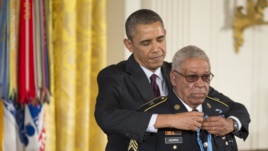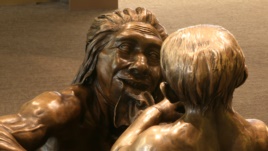Welcome to American Mosaic from VOA LearningEnglish.
I’m June Simms.
Today on the show, we visit a museum where art andscience help tell the story of human evolution.
But first, we hear about some heroic Americans.
Bravery of Soldiers, and Civilians, Honored
Americans who received the highest honor for bravery from the U.S. militarygathered in Knoxville, Tennessee this week. They attended the first showing of a documentary film on the history of the Medal of Honor. But these Americanservicemen and women also recognize bravery among civilians. For severalyears now, Medal of Honor winners have been awarding Citizen Medals ofHonor. The medal recognizes acts of bravery and service in communitiesaround the country.
On a snowy day at Arlington National Cemetery, living Medal of Honor winnersgather to recognize service members killed in the line of duty.
"Thank you for inspiring us then and now with yourstrength, your will and your heroic hearts."
And later at the White House, their numbers increaseas a group of veterans from past wars receive theMedal for their own bravery.
But they also took some time to recognize non-military bravery. They honor agroup of ordinary citizens for their heroic actions in the face of danger.
"We all started to feel this pull, and swimming back to the beach becamedifficult if not impossible for some of the others. I realized that because of myjunior lifeguard training how to recognize that we were in a riptide."
Nineteen-year-old Connor Stotts risked his own life to rescue three friendsfrom drowning in California in 2011.
"The thought never crossed my mind that I would just swim back to shorewithout them."
"Do you consider yourself a hero?”
“I know this is something everyone would say but I don't consider myself ahero. I would consider myself, I hope, more of an example."
 |
| President Obama awards Army Staff Sgt. Melvin Morris the Medal of Honor at the White House. |
Eight years ago, the living Medal of Honor recipients established an award foraverage people who demonstrated bravery, sacrifice and service.
"He was a very caring person who loved to teach and he loved his kids and heloved his family."
Sharon Landsberry remembers the love of her life, Michael. The mathematicsteacher saved students' lives at a shooting at a Nevada middle school lastyear. The 12-year old shooter killed Michael Landsberry. He became the firstcitizen to be awarded the honor after death.
"I know my husband would do it over again if it were to happen again. That was just who he was. He would put his life up to protect those who he loved."
Ronald Rand heads the Medal of Honor Foundation. He says the award isabout selfless service.
"Everyone could be one of those heroes. And, if in fact everyone knew that and recognized that and looked for ways to perform those acts, our societywould be a truly wonderful team of people focused on the right values and theright outcomes."
The Citizen Medal of Honor recipients say they hope their acts of bravery andservice will move other ordinary people to help those in need, and make adifference in their communities.
A popular exhibit at the National Museum of Natural History in Washingtonexplores human evolution. The exhibit includes lifelike representations ofancient primates, or hominids, the early versions of us. Paleo-artist JohnGurche creates a world that modern humans can relate to.
Artist-Scientist Shapes Our Past
The Hall of Human Origins is crowded with visitors. They study five life-sizebronze models. The models show what scientists believe ancient everydaylife looked like, starting millions of years ago. In one representation a homoerectus struggles to carry a newly-killed antelope. Another model shows ahomo floresiensis surprised by a deadly animal. This look at homo floresiensisis set about 18,000 years ago.
John Gurche also created the models of hominid heads found in the exhibit. The artist is an expert in prehistoric subjects and ape and human bodystructure.
“Really to succeed in doing one of these reconstructions, it has to besomething you can relate to as a living being, that you almost expect to seebreathe and you also have to base it on the best science available or else youreally have just a fantasy.”
Mr. Gurche brings faces from the past to life. He starts with a plaster form of a skull. He adds layers of clay and sculpts a face. He covers the work insilicone and adds details and color and to the face. He also attaches hair, onesingle piece at a time. He says what makes the pieces seem so real, though, are the eyes.
 |
|
A Neaderthal mother and her child. |
“I’m trying to build up an impression that there’s someone home. When youlook one of these in the eyes you feel there someone there. There’s somepresence. It really feels like it’s more than just clay and plaster. Hopefullypeople will be a little creeped out by the final result, because they areexpecting to see an inanimate object, but what they are seeing is somethingthat has a little bit of a soul.”
The bronze sculptures capture the moments of the major changes in humandevelopment. Visitors follow their ancestors’ footsteps as they move frommodel to model. They get to see a moment in which early hominids firstwalked on two feet. Visitors observe as brains get larger, fire is discoveredand early humans look for food and react to danger.
“Human evolution as revealed by the fossil record is not just a matter ofeverything we think of as human, starts sort of evolving in tandem together. It’s much more of a mosaic affair, where different things are added at differenttimes. So each species that is a candidate for human ancestry has its ownpiece of the human puzzle that it added to the mix.”
Another representation shows a private family momentin Neanderthal life. John Gurche has created a youngchild watching his mother as she works with an animalskin. The boy’s head is turned a little to the side and up, as if he is questioning something.
“He’s got a piece of skin also and he’s wondering aboutwhat she’s doing and whether he should do the same thing. He’s got that kindof quizzical tilt of his head. And she is responding to him with a lot of joy andhopefully you see some encouragement there is her expression.”
These are not emotions that Stacy Weinberg would usually link to humansthat lived 70,000 years ago. Ms. Weinberg is visiting the exhibit with her twochildren.
“We tend to think that we’ve evolved more and I guess are more intelligentthan people that long ago, but it’s cute because it is a very similar position toone that we might be in today.”
That is the connection John Gurche seeks in his work with our humanrelatives’ long past.
I’m June Simms. Our program was written and produced by Caty Weaver.
Join us again next week for American Mosaic from VOA Learning English.







